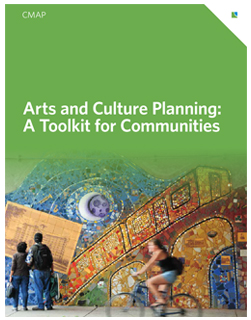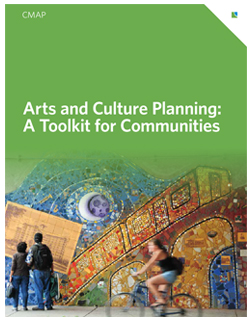Arts and Culture Toolkit
Arts and Culture Toolkit
 Metropolitan Chicago is home to a rich, robust, and diverse cultural ecosystem, with a varied tapestry of artists, nonprofit cultural organizations, for-profit commercial enterprises, arts service organizations, funders, institutions of higher education, and "unincorporated arts," such as street fairs and festivals.
Metropolitan Chicago is home to a rich, robust, and diverse cultural ecosystem, with a varied tapestry of artists, nonprofit cultural organizations, for-profit commercial enterprises, arts service organizations, funders, institutions of higher education, and "unincorporated arts," such as street fairs and festivals.
CMAP has created a new toolkit (PDF) to help municipalities incorporate arts and culture into their communities, enhance livability by improving quality of life, and become more attractive places to live, work, and play. It offers a primer on different types of arts and culture and their inherent primary needs and secondary impacts, then proceeds to detail steps that can be taken by communities:
- Preparation. Creating a local definition for arts and culture, setting goals, and articulating a desired result early in the process.
- Participation and Input. Identifying key stakeholders, exploring and establishing partnerships, soliciting and processing feedback from the community, and vetting and refining of goals and strategies as they are formed.
- Assessment. Evaluating current conditions and identifying potential obstacles as they relate to established goals, essentially asking the question, "What do we need that we don't currently have, and what is stopping us from getting it?"
- Implementation. Formulating policies and regulatory approaches to achieve the vision of the community.
While all steps are important, implementation is where the rubber meets the road. To that end, the toolkit provides model regulatory language that can be used by municipalities to define allowed arts and culture activities within a zoning district, standards for uses to mitigate impacts, provisions to allow and encourage the adaptive reuse of existing institutional structures, as well as guidance as to how to construct an arts district—whether as an overlay district or as base zoning. Because each community is unique, much of this model language is written to allow for modification.
While the toolkit is designed to be comprehensive, it is not intended to be exhaustive. There are too many variations in local context to cover every possible scenario that may be faced by the primary audience—municipal staff and elected officials. Furthermore, a reality of the times is that most municipal staff are stretched as never before, often with one person responsible for the duties of several people who have departed or have been reassigned. This document aims to give those individuals the tools they need to take action by explaining the essential matters to consider and guiding them along a path to implementation unfamiliar to most.
There is extraordinary potential for arts and culture to help communities achieve their broader goals, strengthening the entire region in the process. CMAP hopes that this toolkit will help communities assess their options and choose the arts and culture policies that are right for them.
